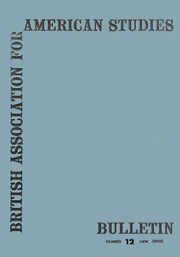No CrossRef data available.
Article contents
Versions of Immobility: The Contemporary American Writer and the Jewish Tradition
Published online by Cambridge University Press: 17 February 2011
Extract
The “Jewishness” of recent American fiction has already been well explored. But discussion of the work of Jewish writers tends to be retrospective: it leads back to the shtetl and the shlemiel without considering how “Americanised” Jewish forms and themes have become. Clearly, recent authors such as Bernard Malamud, Philip Roth and Saul Bellow are indebted to a fund of “Jewish experience”. But their novels are “American”, far more concerned with twentieth-century urban problems than with the enclosed life of the traditional Jewish community. This essay therefore attempts to assess how far “Jewish” localised material has been translated into specifically “American” terms.
- Type
- Research Article
- Information
- Copyright
- Copyright © British Association for American Studies 1966




